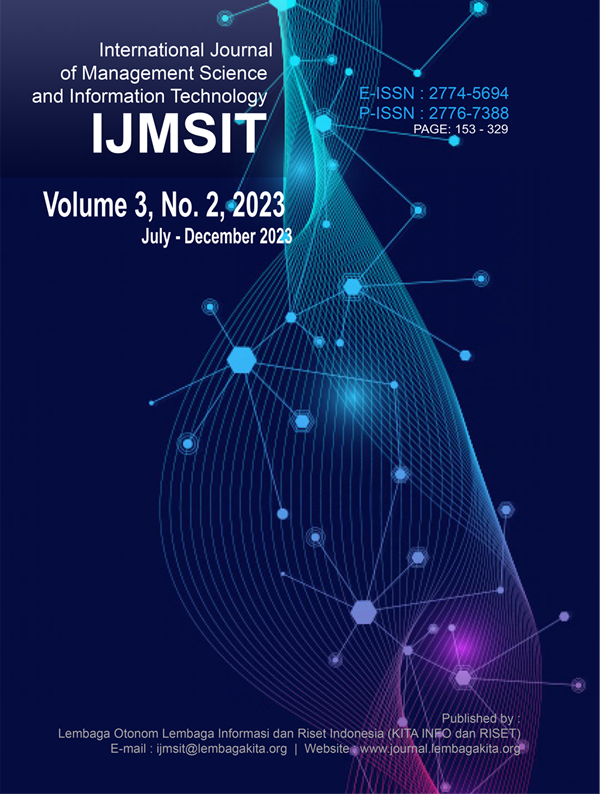Customer Engagement, Customer Equity & Intention to Reuse Mobile Service Applications (A Case Study of Dana Application Users)
DOI:
https://doi.org/10.35870/ijmsit.v3i2.1875Keywords:
Brand Equity, Celluler App, Customer Engagement, Relationship Equity, Reuse Intention, Value EquityAbstract
This study aims to examine the effect of Customer engagement on Customer Equity (Value Equity, Relationship Equity, and Brand Equity) and Repurchase Intention on Mobile service applications. The population used in this study are Indonesian students who have made transactions/purchases through the Dana application. The number of samples used in this study was 200 respondents. Research data was collected by distributing questionnaires through an Online Survey system using Google Forms. The analysis technique used in this study is the PLS-SEM (Partial Least Square - Structural Equation Model) analysis technique with the SmartPLS program to test the hypothesis. The results showed that customer engagement positively affects value equity, relationship equity, and brand equity, which in turn can positively affect repurchase intentions.
Downloads
References
Kumar, V. & Aksoy, Lerzan & Donkers, Bas & Venkatesan, Rajkumar & Wiesel, Thorsten & Tillmanns, Sebastian. (2010). Undervalued or Overvalued Customers: Capturing Total Customer Engagement Value. Journal of Service Research - J SERV RES. 13. 297-310. 10.1177/1094670510375602.
Van Doorn, J., Lemon, K. N., Mittal, V., Nass, S., Pick, D., Pirner, P., & Verhoef, P. C. (2010). Customer engagement behavior: Theoretical foundations and research directions. Journal of service research, 13(3), 253-266.
Sugiyono. (2017). Metode Penelitian Kuantitatif, Kualitatif, dan R&D. Bandung : Alfabeta, CV
Ningrum, I. P. R. (2023). Pengaruh Keterlibatan Konsumen Terhadap Niat Pembelian Kembali pada Aplikasi Seluler (Doctoral dissertation, Universitas Islam Indonesia)
Ho, M. H. W., & Chung, H. F. (2020). Customer engagement, customer equity and repurchase intention in mobile apps. Journal of business research, 121, 13-21.
Kim, K. H., Ko, E., Kim, S. J., & Jiang, Q. (2021). Digital service innovation, customer engagement, and customer equity in AR marketing. Journal of Global Scholars of Marketing Science, 31(3), 453-466.
Bapat, D., & Hollebeek, L. D. (2023). Customer value, customer engagement, and customer-based brand equity in the context of a digital payment app. Marketing Intelligence & Planning, 41(7), 837-853.
Lee, J., & Park, C. (2022). Customer engagement on social media, brand equity and financial performance: a comparison of the US and Korea. Asia Pacific Journal of Marketing and Logistics, 34(3), 454-474.
Hepola, J., Karjaluoto, H., & Hintikka, A. (2017). The effect of sensory brand experience and involvement on brand equity directly and indirectly through consumer brand engagement. Journal of Product & Brand Management, 26(3), 282-293.
Kaushik, P., & Soch, H. (2021). Interaction between brand trust and customer brand engagement as a determinant of brand equity. International Journal of Technology Transfer and Commercialisation, 18(1), 94-108.
Dwiviolita, S., & Zuliarni, S. (2023). Customer Engagement, Customer Equity, and Their Influence on Consumer Repurchase Intention in E-Commerce Mobile Applications. JDM (Jurnal Dinamika Manajemen), 14(1), 55-71.
Lee, K. S. (2022). The Effect of Lifelong Education Quality on City Brand Equity and Intention to Reuse: Focusing on the Case of Lifelong Education in Osan. International Journal of Contents, 18(2).
Ramadhika, D. H. (2021). Pengaruh Kualitas Informasi, Keterlibatan, Dan Ekuitas Pelanggan Terhadap Ketertarikan Konsumen Untuk Melakukan Pembelian Kembali Melalui Aplikasi Belanja Seluler. (Doctoral dissertation, Universitas Islam Indonesia)
Downloads
Published
Issue
Section
License

This work is licensed under a Creative Commons Attribution-NonCommercial-NoDerivatives 4.0 International License.
Copyright and Licensing Agreement
Authors who publish with this journal agree to the following terms:
1. Copyright Retention and Open Access License
- Authors retain full copyright of their work
- Authors grant the journal right of first publication under the Creative Commons Attribution 4.0 International License (CC BY 4.0)
- This license allows unrestricted use, distribution, and reproduction in any medium, provided the original work is properly cited
2. Rights Granted Under CC BY 4.0
Under this license, readers are free to:
- Share — copy and redistribute the material in any medium or format
- Adapt — remix, transform, and build upon the material for any purpose, including commercial use
- No additional restrictions — the licensor cannot revoke these freedoms as long as license terms are followed
3. Attribution Requirements
All uses must include:
- Proper citation of the original work
- Link to the Creative Commons license
- Indication if changes were made to the original work
- No suggestion that the licensor endorses the user or their use
4. Additional Distribution Rights
Authors may:
- Deposit the published version in institutional repositories
- Share through academic social networks
- Include in books, monographs, or other publications
- Post on personal or institutional websites
Requirement: All additional distributions must maintain the CC BY 4.0 license and proper attribution.
5. Self-Archiving and Pre-Print Sharing
Authors are encouraged to:
- Share pre-prints and post-prints online
- Deposit in subject-specific repositories (e.g., arXiv, bioRxiv)
- Engage in scholarly communication throughout the publication process
6. Open Access Commitment
This journal provides immediate open access to all content, supporting the global exchange of knowledge without financial, legal, or technical barriers.












